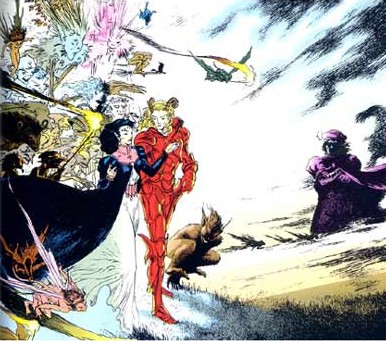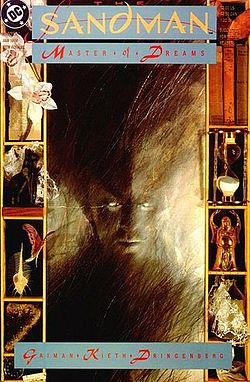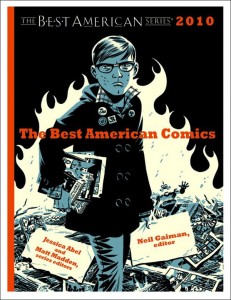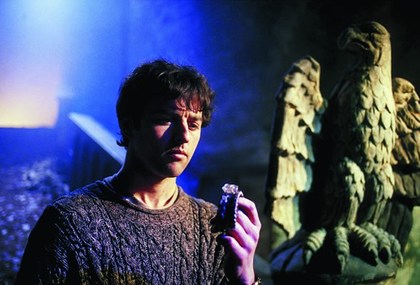James Romberger and Robert Stanley Martin had an interesting back and forth on Gaiman and Sandman in comments, which I thought I’d reprint. (I haven’t reprinted everything they said, and there were other folks in the conversation too…click through to the thread for the whole back and forth.)
James started with a response to my piece on Gaiman’s editing of Best American Comics.
Yes, anyone can do comics, but few can master them. The book perhaps reflects that Gaiman doesn’t truly understand the art of graphic storytelling. It is as if he views comics as a stepping stone to other, more profitable forms of expression. I doubt that he is aware why the best comics bearing his name are those done by highly-skilled cartoonist P. Craig Russell, who adapts Gaiman’s text entirely to the comics medium and adds his own sense of timing and poetic visual orchestration to the pages. Left to his own devices, Gaiman’s work is verbose to the extreme. His better artists such as Charles Vess, Dave McKean, Jill Thompson or Chris Bachelo can add extremely sophisticated visuals to the work, but they are exceptions rather than the rule; one gets the sense that to Gaiman, artists are expendable and interchangable. He rarely discusses their contributions with much acuity or depth. He is the star of his own show, so his most lasting legacy is Vertigo’s writer-centric crediting system, writers in large type on the covers, artists as appendages.
He added.
I’ll concede that it is Vertigo who have long had the tendency to put out comics with pages by one artist cut through with jarringly random pages by another, that it is Vertigo who decided to make the writers’ interests supercede that of the artists, beginning the negative credit trend that has infected the entire industry. Perhaps I am overmuch blaming Gaiman and those of his fellow writers who allow this type of thing to happen—maybe they don’t have a say in a policy that gives them the advantage. I do like the Russell adaptations much more than Gaiman’s other work, but I also admire a few of the other collaborations, particularly the Shakespeare revisioning with Vess and and the inventive Mr. Punch with McKean. And I suppose I could be holding it against him that when I met the guy he was dismissively rude.
It does seem that the “Best of” series feels interchangable with the Anthologies of Graphic Fiction and that hardcover McSweeneys collection in that many of the same cartoonists are in all of them, and have been lumped together to form a sort of “new establishment” of comics. I begin to feel bad for some of the individual victims who do not deserve to be made part of any army but who because of this generalization appear ripe to be overthrown, as all establishments deserve to be.
Robert Stanley Martin replied.
Eddie Campbell on the prominence of Neil Gaiman’s credit on the Sandman jackets, from TCJ #273:
In the latest editions of the Sandman books, I noticed Neil Gaiman’s name up along the top there, as Neil Gaiman’s Sandman. It’s taken some getting there, but it finally got the author’s name on the top of the book. And any artist who’s ever worked on that, I think, he or she knew full well they were doing so as Neil’s guest. Neil is the author of those books. Doesn’t mean he’s the only person working on them, any more than David Bowie’s the only person working on one of David Bowie’s albums.
Gaiman wrote “Ramadan” as a short story for Russell to adapt. He wanted to see Russell give it the treatment given to other works such as the various operas and Oscar Wilde’s fairy tales.
I haven’t read a Sandman episode in about fifteen years, so I can’t say how well they hold up. (I looked at Mr. Punch again in conjunction with the poll last year, and I gave up on it after about 20 pages.) Regardless, the Sandman material is one of the few things in comics one can show people outside the subculture and have a reasonable expectation that they might hook into it. Gaiman may not be a good storyteller per certain factions of the comics subculture, but his stuff has an appeal to the culture beyond that. He’s one of the handful of comics creators this can be said of, and I think it’s nothing to sniff at.
Robert added:
As for the substance of Eddie’s statement, I actually agree with you for the most part. I do think Gaiman’s collaborators are the co-authors of the individual stories they work on with him. However, I also believe that Gaiman should be considered the author of the Sandman series overall. Eddie made a music analogy, so I’ll make one, too. “My Little Town” is a Simon and Garfunkel record, but the album it appears on, Still Crazy After All These Years, is a Paul Simon solo album, and rightly so. He’s responsible for the direction of that album in the same way that Gaiman was responsible for the direction of the Sandman series. The collaborations don’t change that.
And James responded:
Eddie does most of his work on his own, and so is, I think, self-effacing and somewhat less invested in his collaborative mode…he can afford to be generous with credit.
I suppose you are making a case that Gaiman is like the late Harvey Pekar, another writer whose work I admit that I am not very fond of, who also worked with a lot of different artists, did not have much of a visual sensibility (IMO) and dominated the credit on his collaborations. I guess I can see your point. The bottom line for me is that I am not usually interested in the comics done by either of these writers, it seems to me that much of their work could just as easily have done in another medium…it is no surprise that they both gravitated in more recent years to film.
Charles Vess’ art for Sandman




